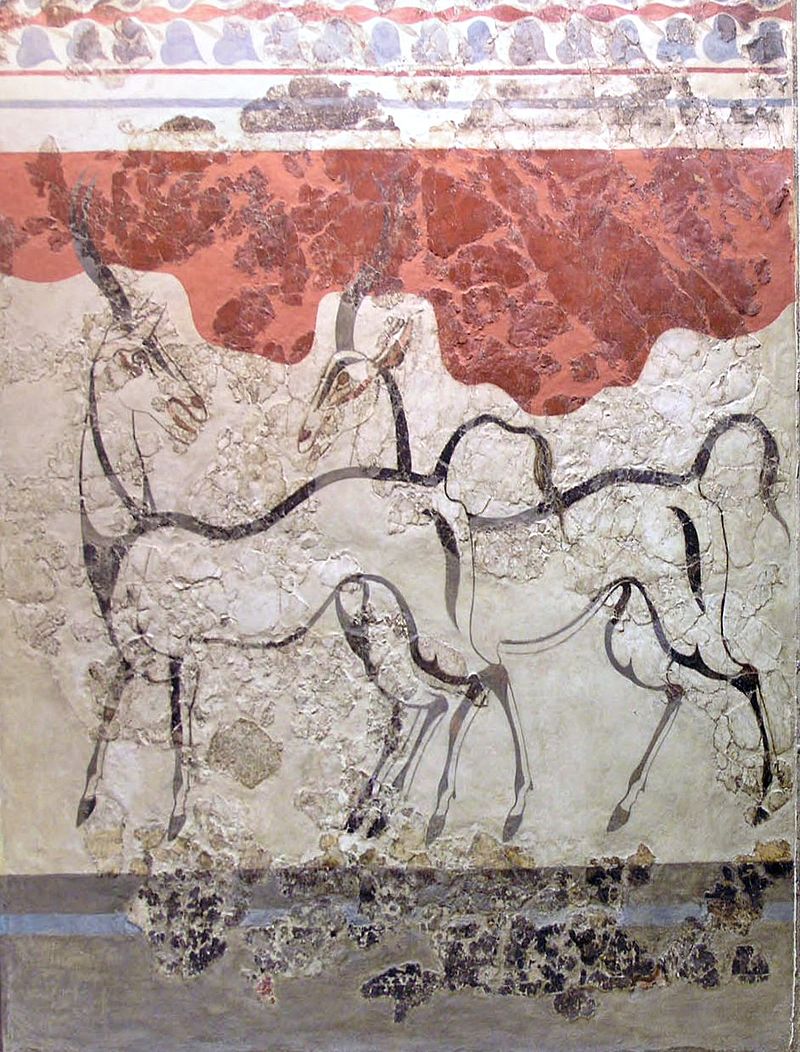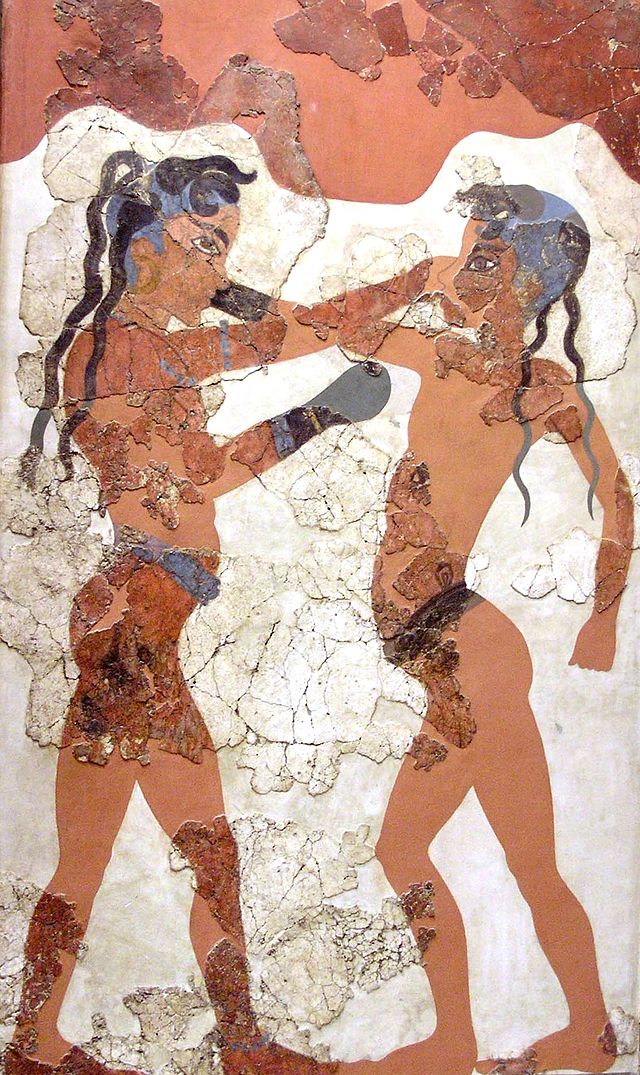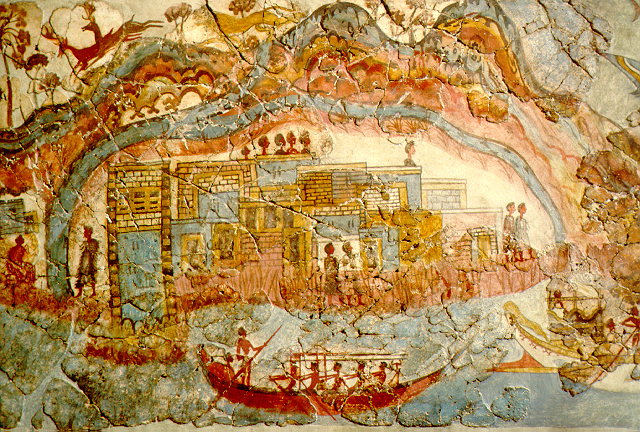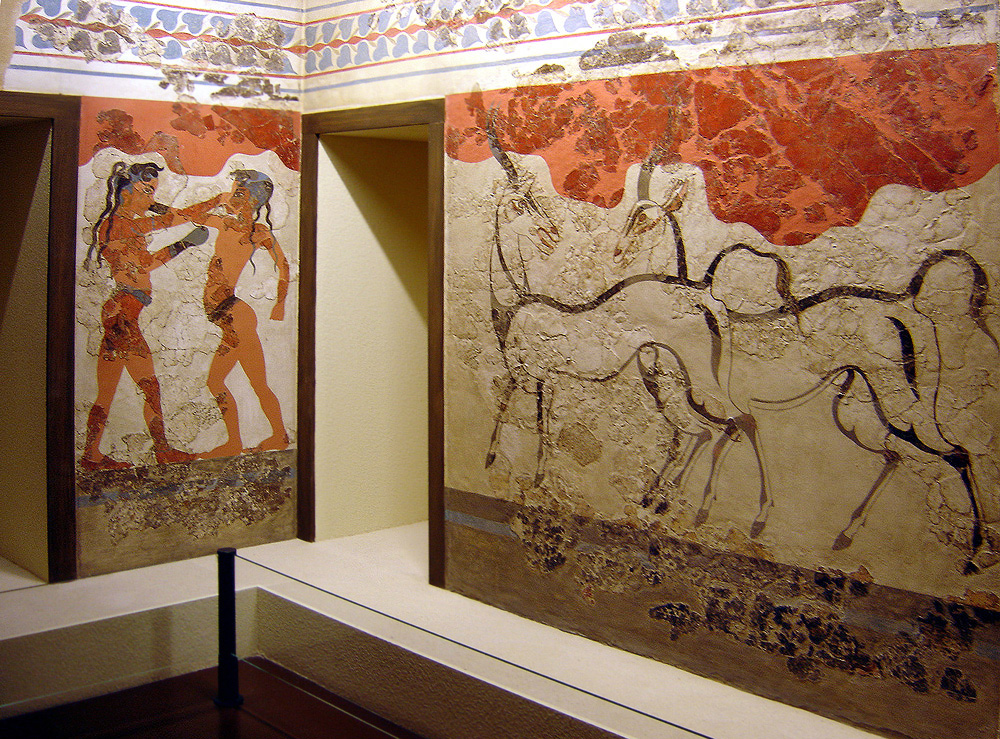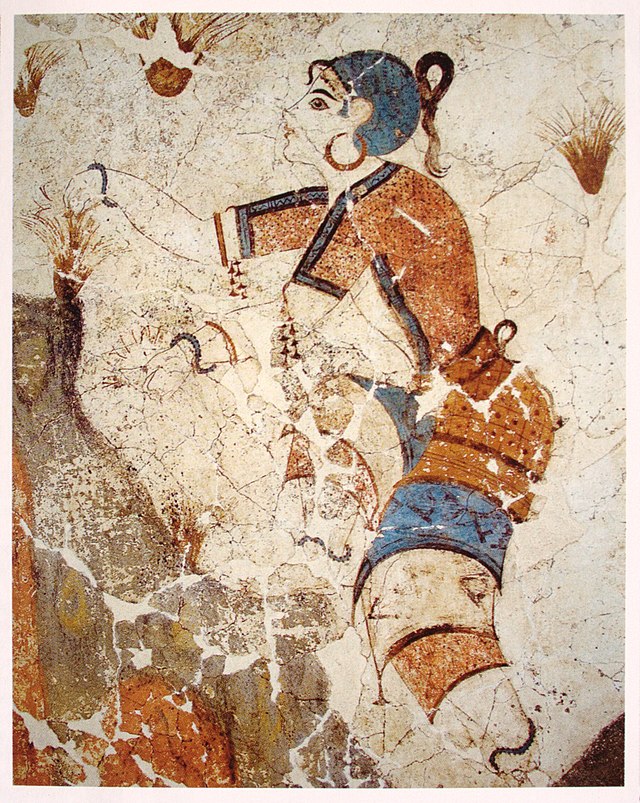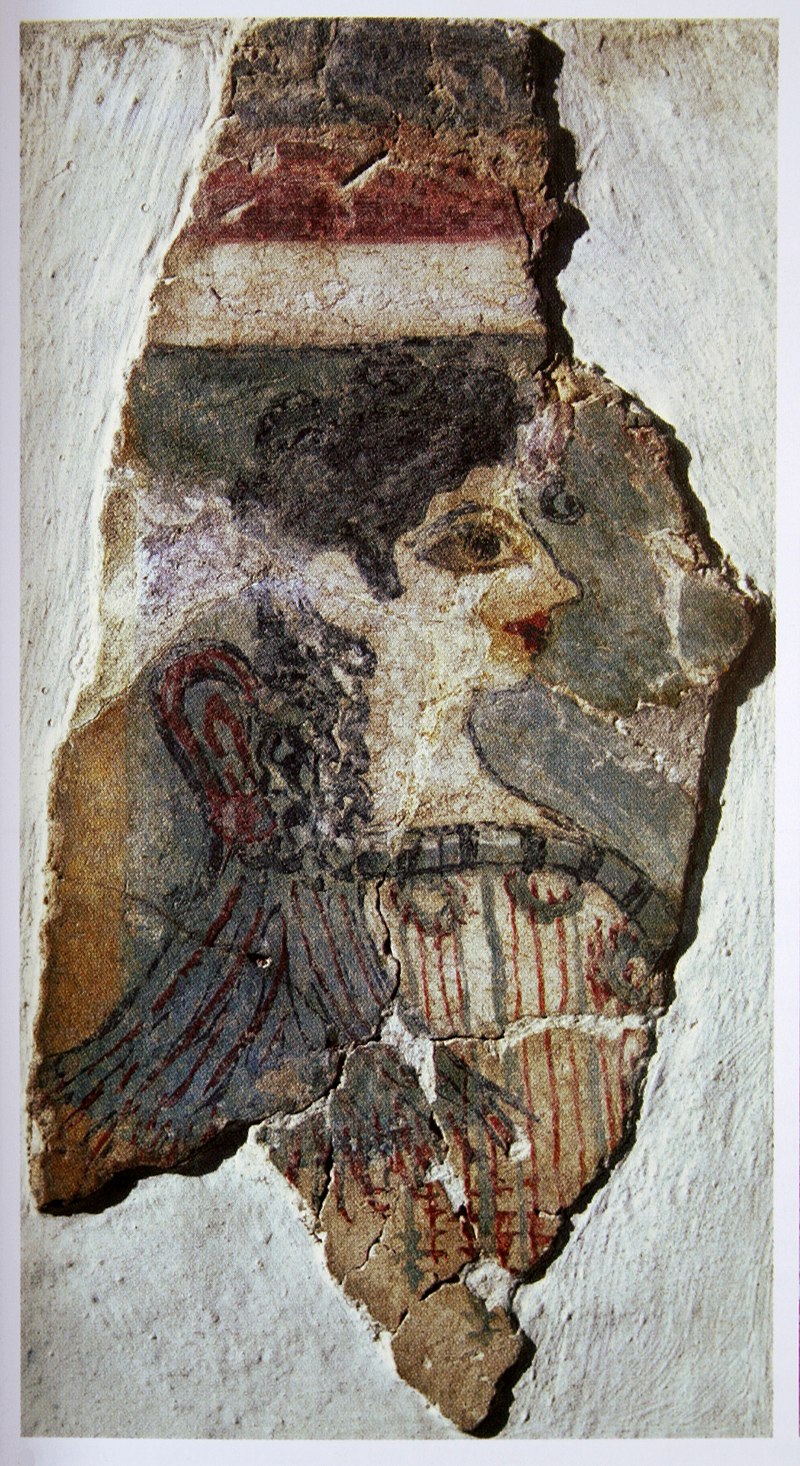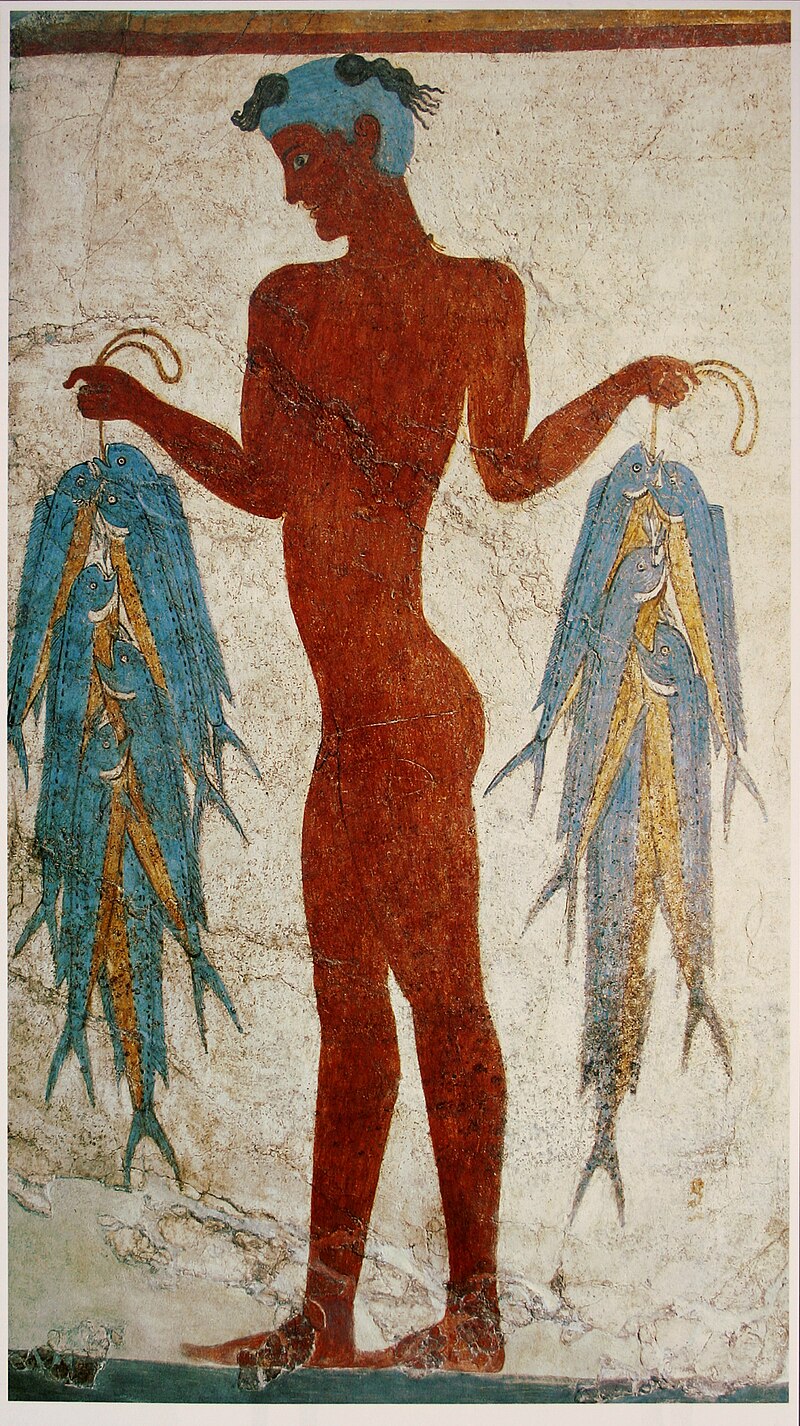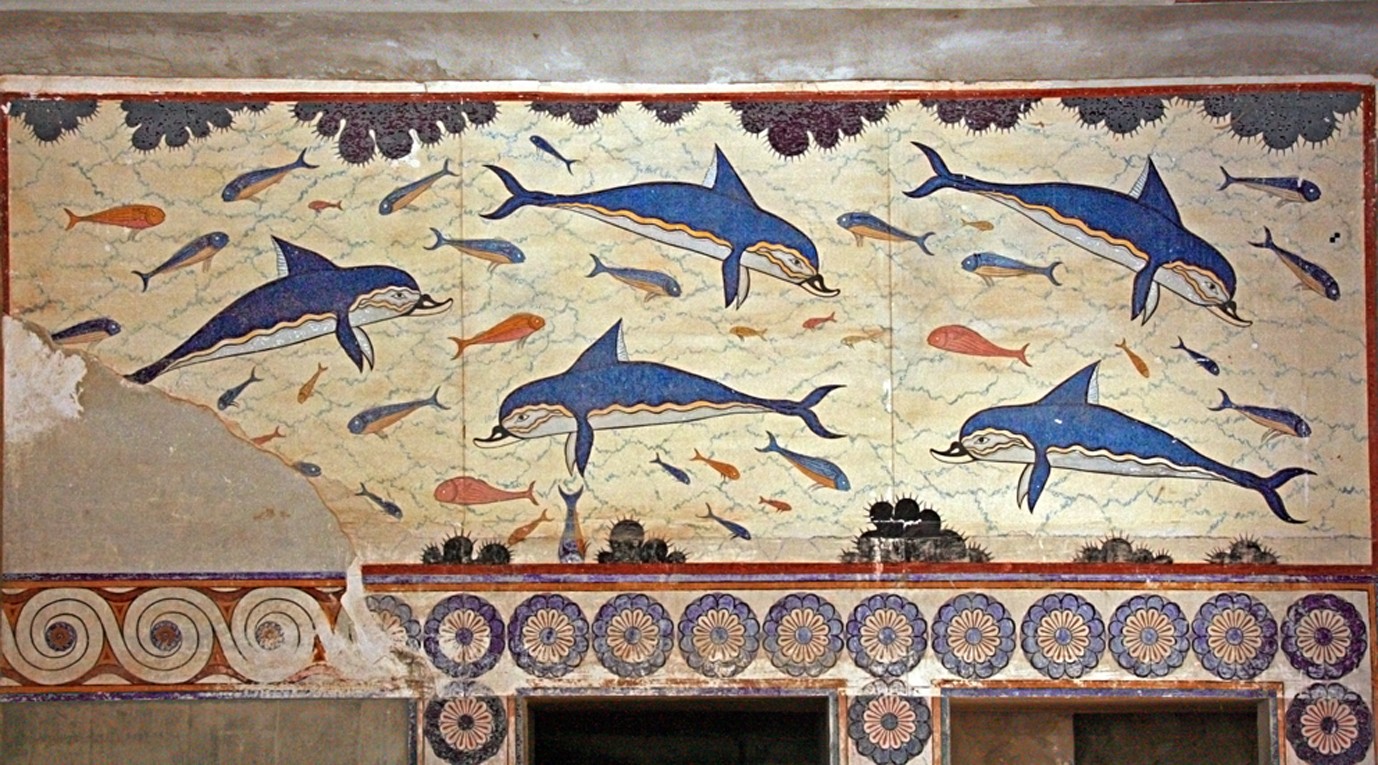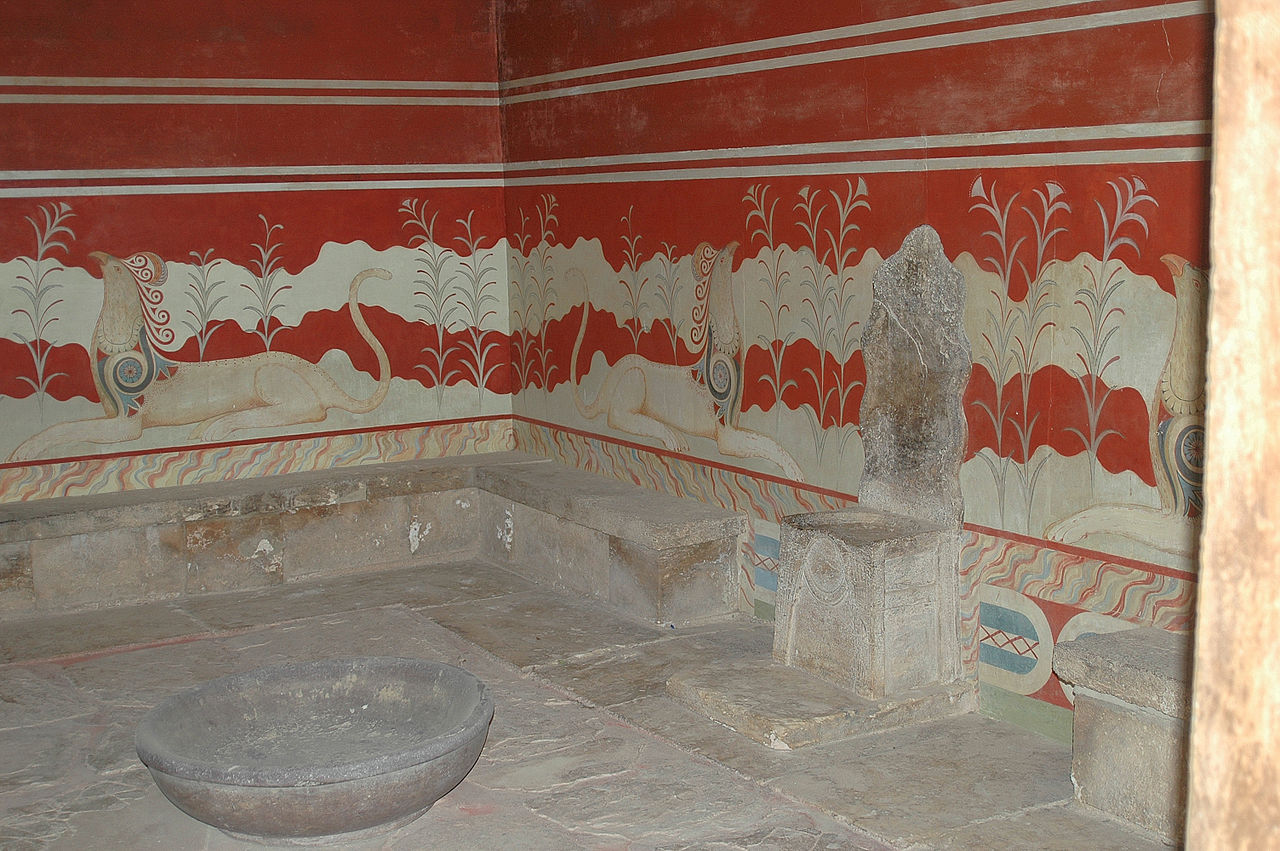In
the eastern section of room 1 of the House of Ladies, two female
figures are engaged in an unknown activity. However, only a small
portion of the figure’s skirt and forearm remain.
The woman
depicted has rich, flowing black tresses and a red streak on the cheek.
She wears a gold ear-ring and a bracelet on her left arm. The position
of the arms made it impossible to depict a necklace. The figure is shown
bending forward at an angle of about 70°, so that her inordinately
large breast is exposed and hangs down from the decolletage of her
bodice. This lady’s feet also protrude from beneath her Minoan style
skirt. Again the position of the arms indicates that she is
participating in some activity taking place in front of her (east)
where, in the course of the reconstruction of the frescos, a fragment of
wall-painting probably showing part of the arm of another female figure
has been placed. Exactly below the surviving fragments of the arms of
the bare-breasted figure, is preserved part of the representation of
another Minoan skirt which creates a little visual confusion.
The most popular interpretation of this wall-painting suggests a
religious significance. An alternative interpretation is that this
wall-painting celebrates an important event in the life of the a
missing figure.



The frescoes of three elaborately dressed women were found in the
“Lustral Basin” of Xeste 3. They appear to be heading towards what
scholars have interpreted as an altar/shrine. The women’s rich clothing,
fine jewelry, and meticulous grooming indicate the social status and
importance of this composition.
This replica shows the first figure from the left, the western most,
advancing towards the altar. In her left hand a necklace of rock crystal
beads. She is portrayed with her head in profile, her chest in
three-quarter pose and the lower body in profile. Her curvaceous body is
readily discernible beneath her transparent sleeved bodice, which is
embroidered with crocus stamens. As in many other Minoan frescoes, her
breasts are bared. Although the artist skillfully conveys the allure of
the female form through the transparent fabrics, he has some limitations
conveying the perspective of the right breast. This, like his Egyptian
contemporaries, depicts an elegant young female with just one breast.



Mini Papyrus Plants
Found in the West section of the House of Ladies, frescos of massive,
three stemmed, blossoming plants are painted on the walls. The lower
zone is painted in a reddish-yellow color with an undulating curve,
presumably an attempt at rendering uneven ground. The stems spring from
clusters of outwardly curving leaves and bear bell shaped flowers. The
stamens project above the rim of the flower. The colors used by the
artist in rendering the plants are black, blue and yellow. In the
repetitive motif, each grouping of the plants shows clusters of three
stalks surrounded by two triads of leaves and the fixed number of seven
stamens.
Dual Papyrus Plants
Found in the West section of the House of Ladies, frescos of massive,
three stemmed, blossoming plants are painted on the walls. The lower
zone is painted in a reddish-yellow color with an undulating curve,
presumably an attempt at rendering uneven ground. The stems spring from
clusters of outwardly curving leaves and bear bell shaped flowers. The
stamens project above the rim of the flower. The colors used by the
artist in rendering the plants are black, blue and yellow. In the
repetitive motif, each grouping of the plants shows clusters of three
stalks surrounded by two triads of leaves and the fixed number of seven
stamens.
The Saffron Goddess
The Saffron Goddess is a detail from a fresco depicting a saffron
harvest. The flowers are being picked by young girls and monkeys. This
Minoan goddess supervises the plucking of flowers and the gleaning of
stigmas for use in the manufacture of what is possibly a therapeutic
drug. Standing guard is a stylized griffin. The mythological griffin,
thought to be an especially powerful and majestic creature, was
considered to be a combination of the body of a lion as king of the
beasts and the head of an eagle as the king of the birds. Minoan
frescoes are the first botanically accurate visual representations of
saffron’s use as an herbal remedy. Minoans discovered the value of
saffron and there is enough evidence to believe that they were using it
to treat wounds. This theory is reinforced in another fresco from the
site which depicts a young woman using saffron to treat her bleeding
foot. (Fresco to come)
The Saffron Gatherer
The Egyptians had a limited number of colors that they used for their
murals. White, black, red, yellow, blue and green. The pigments that
were used were almost all manufactured from naturally occurring mineral
substances. The Egyptians later learned to create mixed colors from the
primary ones, such as grey, pink, and brown.
This replica shows two women are depicted in a field of crocuses. The
older figure (not shown) is gathering flowers with her right hand, while
holding a basket in her left. The younger figure, with the shaved blue
head, is gathering the stamens with both hands. The age difference,
manner of dress and the way they're interacting may imply that this
figure is a student. The Crocus grows even today on the Aegean islands
and mainland Greece. Saffron, which is derived from the stamen of the
crocus, has been used as a dye, a medicine, a spice and a perfume for
centuries. Saffron in Akrotiri likely used for the dyeing of robes.
Saffron-colored robes are found throughout the wall-paintings, mostly
adorning women. In Classical Greece, crocus dye was a symbol of
supremacy and wealth.
The ancient inhabitants of the island of Thera were quite aware that
they had built their city on a volcanic island, as evidenced in this
painting in the black and red volcanic stone and soil on which the girl
is gathering her flowers.
Since these plants are stylized, their actual identification
has caused much academic debate. Since the late 1960s, they have been
recorded as sea-lilies, sea daffodils or Papyrus. Sea-lilies still grow
on the beach and seaside of Santorini, blooming in late summer. But
recent studies have concluded that these flowers are more likely to be
papyrus. Not only do the Theran stylistic renditions of these flowers
have parallels in Egyptian papyrus imagery, but also evidence suggests
the existence of papyrus in Crete during the Bronze Age. Also, the
height of the flowers, which fill the walls, suggest a scale better
suited to a papyrus than to the much smaller sea-lily. Papyrus grows to
up to the scale of the frescoes and displays a symmetry equivalent to
the flowers in this wall-painting.
Since these plants are stylized, their actual identification
has caused much academic debate. Since the late 1960s, they have been
recorded as sea-lilies, sea daffodils or Papyrus. Sea-lilies still grow
on the beach and seaside of Santorini, blooming in late summer. But
recent studies have concluded that these flowers are more likely to be
papyrus. Not only do the Theran stylistic renditions of these flowers
have parallels in Egyptian papyrus imagery, but also evidence suggests
the existence of papyrus in Crete during the Bronze Age. Also, the
height of the flowers, which fill the walls, suggest a scale better
suited to a papyrus than to the much smaller sea-lily. Papyrus grows to
up to the scale of the frescoes and displays a symmetry equivalent to
the flowers in this wall-painting.
In Minoan society everything was
painted on: walls, floors, toys,
pottery, figurines, columns, and
even clothing, but sadly only 5-10%
of any given fresco survived. In
temples wood columns were painted
red, and stone friezes commonly show
rosettes. True frescoes are painted
on wet lime plaster, but Minoan
artists also painted on dry
surfaces. This was in stark contrast
to their Egyptian neighbors, who
painted directly on limestone or dry
gypsum plaster. Wall and ceiling
plaster was sometimes modeled in
relief, such as the spiral relief in
the north wing of Knossos, the bull
relief at the north entrance
passage, and the bull-grappling
fresco in the east wing. Frescoes
are found everywhere: in houses,
shrines, and in temples.

|
|
The Hall of the Shields at
Knossos
|
The origin of fresco painting is
truly in the neolithic and EM
periods. Important buildings during
the FN (final Neolithic) and EM
periods had their walls and floors
covered in plaster. This early
plaster consisted of lime mixed with
clay, and was sometimes colored red
or black, strikingly similar to the
conventions of Catalhoyuk's plaster
wall painting thousands of years
earlier in the 7th
millennium BCE. By the MM period,
around 1,900 BCE, Minoans began to
paint red and white geometric
patterns on temples, they used flat
washes on their temple walls. The
earliest true frescoes are from
around 1,700 BCE and the practice
flourished during the NT period.
Many early frescoes used dark red
prominently, and the color continued
its prominence through the NT period
as the color of the Knossian
palace's columns.

|
|
A diagram of the pigments
used in Minoan frescoes
|
By the MM period high purity lime
plaster and a greater variety of
pigments allowed fresco painting to
proliferate. The colors used in
frescoes came from a wide variety of
sources. Red and yellow came from
ochers, black from carbonaceous
shale or charred bone, blue from
copper tinted glass or ground lapis
lazuli. Green, pink, and grey were
created from mixing pigments, but
shading in light and dark was never
used. Minoans painted real figures
such as humans and animals, but not
everything was done in a strictly
realistic manner. Abstract swirling
geometric designs are intricately
incorporated into many frescoes,
most notably into the griffins in
the Throne Room at Knossos. Fresco
painting usually involved three
zones: repeating patterns above
windows or doorways, the main
composition in the center of the
wall, and dado at the floor level,
often imitating stonework.

|
|
A decorative frieze at the
palace at Knossos
|

|
|
Detail from that frieze |
|

|
|
Detail of a rosette on a
griffin in the Throne Room
fresco at Knossos. The
rosette is located on the
griffin's shoulder, it
should be noted that this
picture is upside down and
the flowers actually point
downward | | | |
|

|
|
Decorative rosettes from a
fresco at Akrotiri, on the
island of Thera
|

|
|
Detail of a fresco now in
Evan's reconstructed
“Gallery”
|
Animals are commonly found in
frescoes, especially monkeys.
Monkeys are always painted blue, as
was the Egyptian fashion, some even
wearing harnesses. Dolphins, fish,
and octopuses are common subjects.
People are often shown smiling.
While there are scenes of nature in
Minoan frescoes, they are often
exacted with an unrealistic
aesthetic strategy, and incorporate
a kind of abstract minimalism. The
Spring fresco in Akrotiri shows this
design style, as flowers and birds
become a few interspersed brush
strokes. The background in the Blue
Bird fresco also exhibits this
aesthetic sense.

|
|
The Spring fresco in full,
at Akrotiri
|
|
|
|
|
|

|
|
The lily fresco from the
storeroom of house X of the
southern area, Kommos,
Crete, Minoan
|

|
|
Detail from the Monkey
fresco
|

|
|
Blue Monkeys from the Beta
6 fresco at Akrotiri
|

|
|
The Blue Bird fresco from
the House of the Frescoes at
Knossos
|

|
|
The Blue Bird fresco in
full
|

|
|
Detail of the Dolphin
fresco at Knossos
|

|
|
Minoan frescoes of goats
and the Boxer fresco at
Akrotiri
|
|
|
|
|

|
|
A flying fish from a Minoan
fresco
|
Minoan miniature frescoes are
impressive, and from 1,700-1,400
Crete was the epicenter of Aegean
fresco artistry. The sizes of
frescoes ranged from truly tiny (a
few centimeters across) to life
sized humans. On the Procession
fresco in the Knossos labyrinth
fabrics are etched onto the figures
with a string, allowing for ultra
detailed lines and patterns. The
attention to extreme detail shows
itself in the intricately designed
clothing on the life sized frescoes,
such as the Cupbearer at Knossos,
and the elaborate Procession fresco.
The Villa of the Lillies at Amnisos
includes 7 zones of differing ocher
use with a decorative criss-cross
pattern.

|
|
The Cupbearer fresco from
Knossos
|

|
|
The Procession Fresco, this
picture is actually much
larger, please download it
and zoom in
|
When ceremonies are depicted in
frescoes, the priestesses are shown
bedecked in bright colors, and are
always central in the painting's
narrative. Forming a background to
the priestess foreground in such
frescoes is the crowd, the commoners
who flocked to such celebrations. In
the Sacred Grove fresco they are
drawn without individual identities
only represented as a repeating
pattern of bobbing faces lost in a
sea of dark red. This was partially
done out of necessity, as the entire
fresco itself is already a
miniature, making each face
extremely small and details neigh
impossible. The skill required to
make this miniature fresco is
astounding, and even with the size
constraints the artist managed to
create a pleasing and distinctively
Minoan aesthetic.
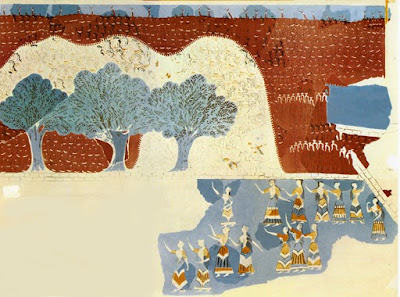
|
|
The Sacred Grove miniature
fresco
|
Arthur Evans assumed that Minoans
were great lovers of nature since
natural scenes are heavily
represented in their frescoes. This
wrongheaded stereotype of Minoan and
LBA Aegean culture is still somewhat
pervasive in modern society. In the
academic community much of Arthur
Evans' interpretation has been
debunked, Arthur Evan's
interpretation relies too heavily on
his own western sensibilities. When
Evans saw nature, he saw placid and
idyllic romanticism, and in doing so
overlaid his 19th century
world view onto the Minoan
world.
“...the roses on their tea cups
and the ivy-covered trellises on
their wallpaper would not blind us
to the Victorians' capacity to
exploit child labor and commit
acts of ruthless military
aggression in India and Africa.” - Rodney Castleden

|
|
The “sacral ivy” fresco
from the House of the
Frescoes, Knossos, from pg
67 of The Arts in
Prehistoric Greece, by
Sinclair Hood
|
Much of the Minoan's frescoes depict
not nature strictly, but show an
entire other world. As Castleden
puts it, they
“call down deities” as the
individual's experience of the
frescoes was entirely intertwined
with its cultic aspects. The
frescoes are brimming with meaning
lost now to humans today, a meaning
significantly more complex than
Evans' “reverence of nature”. The
plants and animals often depicted in
frescoes are in fact not natural,
but supernatural. Imaginary plants
are shown, curled into elaborate
spirals. Various plants which
bloomed at different times of the
year are seen in frescoes blooming
together, setting the whole scene
apart from a standard depiction of
the natural world. Otherworldly
Griffins are a common theme in
Minoan art but their intended
symbolic usage is also now lost on
us. They seem to always accompany
priestesses cementing their
connection between Minoan myth and
the real world. On the famous Agia
Triadha larnax (a clay sarcophagus)
a goddess is shown driving a chariot
pulled by griffons. There is no
explanation for what that scene
represents, but certainly it is
outside of the natural world and
depicts the realm of myth. Frescoes
are often used as symbolic
“signposts”, such as painting
processions in hallways in which
processions took place. It is very
likely that the minds of many
Minoans would have entirely
connected these frescoes to their
cultic activities. What did
priestesses think when they saw
frescoes of griffons, and what did
artists feel as they painted such
scenes? We sadly do not know.

|
|
Detail of the Griffin
fresco from the Throne Room
at Knossos
|

|
|
A wider shot of the Throne
Room at Knossos
|
What is not so clearly seen in
Minoan art is their darker side.
Bull sacrifices are not shown except
in one spot: on the Agia Triadha
sarcophagus. This lone depiction of
the funerary practices obviously
shows gore, with the bull on a
sacrificial table surrounded by
blood. There is a naval battle shown
on the north wall frieze of room 5
of the west house, which shows the
dead floating in the water and
soldiers dressed to kill with
helmets, spears, and shields. A
fresco from Akrotiri shows an altar
covered in the blood of recent
sacrifices, and the Boxer rhyton
includes one individual being gored
by a bull. These scenes of violence,
combat, and blood, are few and far
between and the vast majority of
frescoes do not show these gruesome
consequences of Minoan practices and
naval military dominance.

|
|
The sacrificial bull from
the Agia Triadha
sarcophagus
|

|
|
Casualties in the water,
from the naval battle fresco
at Akrotiri
|
Minoan fresco art shows their
culture only insofar as they desired
to see themselves. Both male and
female figures are often physically
toned and proportionally beautiful,
wearing elaborate and form fitting
clothing. Minoan frescoes imitated
Egyptian frescoes and often painted
men in a rosy hue and women in a
whiter tone. Even as this is the
case, there is much ambiguity when
ascertaining the gender of figures
with some pieces (such as the Priest
King fresco) being neither red nor
white. The beautiful and sculpted
human figures seen in Minoan
frescoes were intended to grace the
halls and rooms of the rich, either
in their private residences or on
the palace-temple's walls. Workshops
by the Royal Road in Knossos also
include frescoes, and Akrotiri on
the island of Thera includes
frescoes in every building
excavated. The use of frescoes at
Akrotiri flies in the face of the
exclusive Knossian temple frescoes,
suggesting that frescoes were
incorporated into many class levels
and were brought into the daily
lives of more common people. This
liberal use of fresco art also
suggests that if the remainder of
the city of Knossos is explored one
would find frescoes commonly as
well, although it is possible that
each town would have had a different
relationship with its
painters.
Frescoes only show one aspect of
Minoan culture. Not everything was
included as a fresco or painted on a
jar, and even then what has survived
is only a minute fraction of the
whole. The complexity between
individuals and art, and between art
and symbolism, are both completely
intertwined with each other and
completely invisible in the material
record. It would be impossible to
deduce the complexity of 12th
century CE medieval society from
their stained glass windows, while
their existence speaks volumes about
the lives of those who lived at the
time, it does not tell the full
story. Also an interesting problem
to note is that an entire species of
crafted art (carved wood) has
completely disappeared. This is a
huge gap in knowledge, so huge its
total effective loss is unknown. It
would be similarly difficult to
truly understand medieval society if
by chance no stained glass windows
had ever been discovered.
.jpg)
|
|
Inaccurate reconstruction
from 1914 of a fresco,
attributed to Emile
Gillieron the son. Actually
the blue figure was a
monkey, the tail of which is
seen on the right
|
Minoan frescoes are not
only found on Crete, or at the
nearby Minoan settlement of Akrotiri
on Thera, but they are found around
the Aegean. Minoan style frescoes
are found on the Aegean islands of
Melos, Keos, and Rhodes, strikingly
similar to NT period designs.
Frescoes are also found outside the
Aegean, such as at the palace of
Yarim-Lim at Alalakh in Syria, where
a Minoan style griffin was painted.
A Canaanite palace at Tell Kabri had
a painted plaster floor and
miniature frescoes similar to the
ones found at the West House at
Akrotiri. Fragments of frescoes
found at the royal palace at Qatna,
Syria, show Minoan influence, such
as spirals, imitation stonework,
palm trees, and riverside scenes
with crabs and turtles. The most
spectacular Minoan frescoes are seen
at Avaris in Egypt, the capital of
the Hyksos dynasty of Egypt. These
frescoes show rocky landscapes,
bulls and acrobats, griffins, maze
patterns, half rosette friezes, and
one leaper has a Theran hairstyle.
It is entirely impossible to prove
whether these sites around the
eastern Mediterranean were done by
Minoans or simply by local artisans
copying Minoan styles. Either way,
the cultural dominance of Minoan
artistry was paramount across the
near eastern world, popular enough
to be desired by foreign rulers from
across the sea.

|
|
A scene of birds, a wall
painting fragment from the
Malkata palace made in later
reign of Amenhotep III who
died in 1,353 BCE. While
this fresco is distinctively
Egyptian, the upper border
of the scene is reminiscent
of Minoan abstract dados and
includes a repeating pattern
of rosettes
|
References

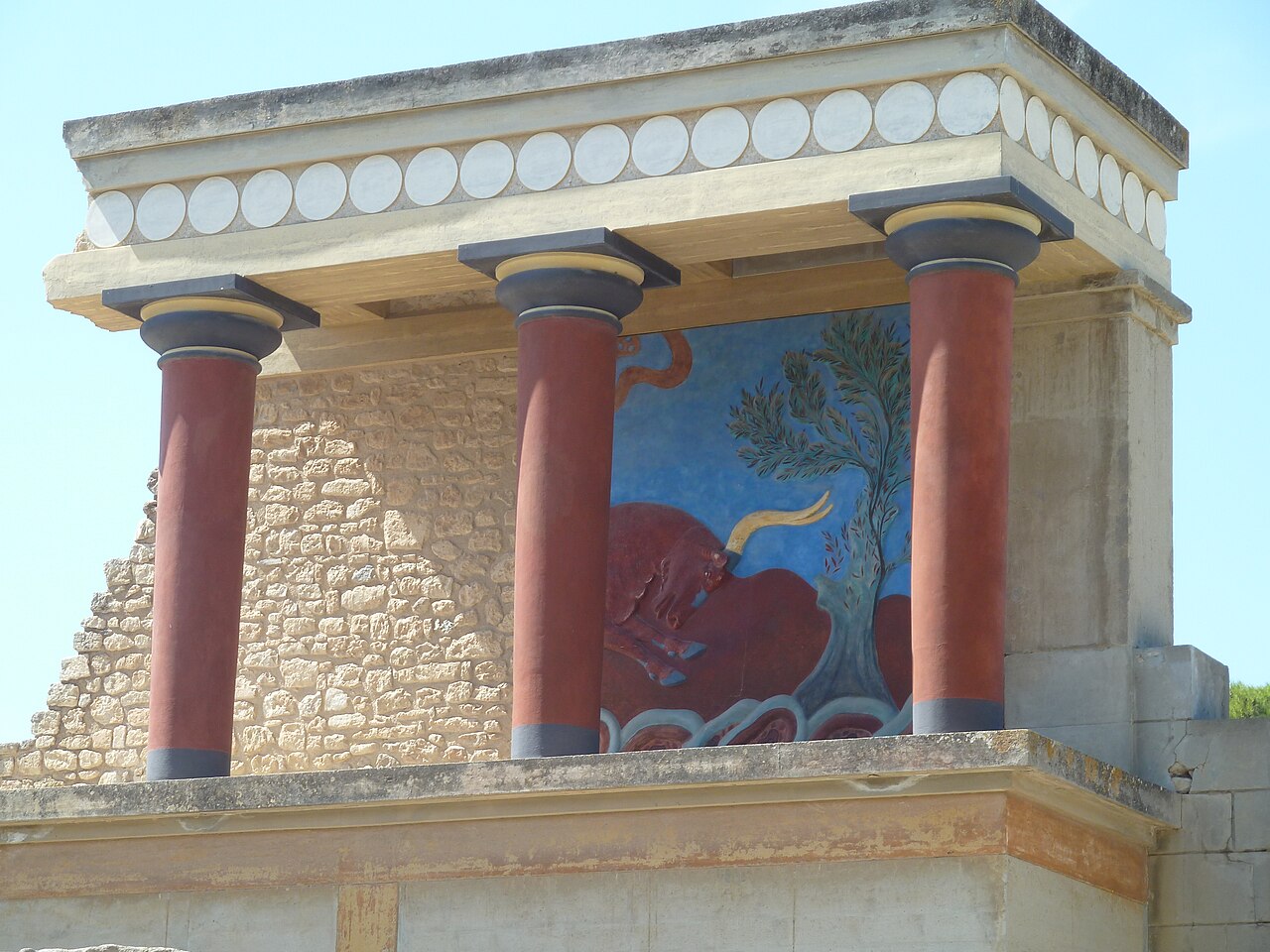

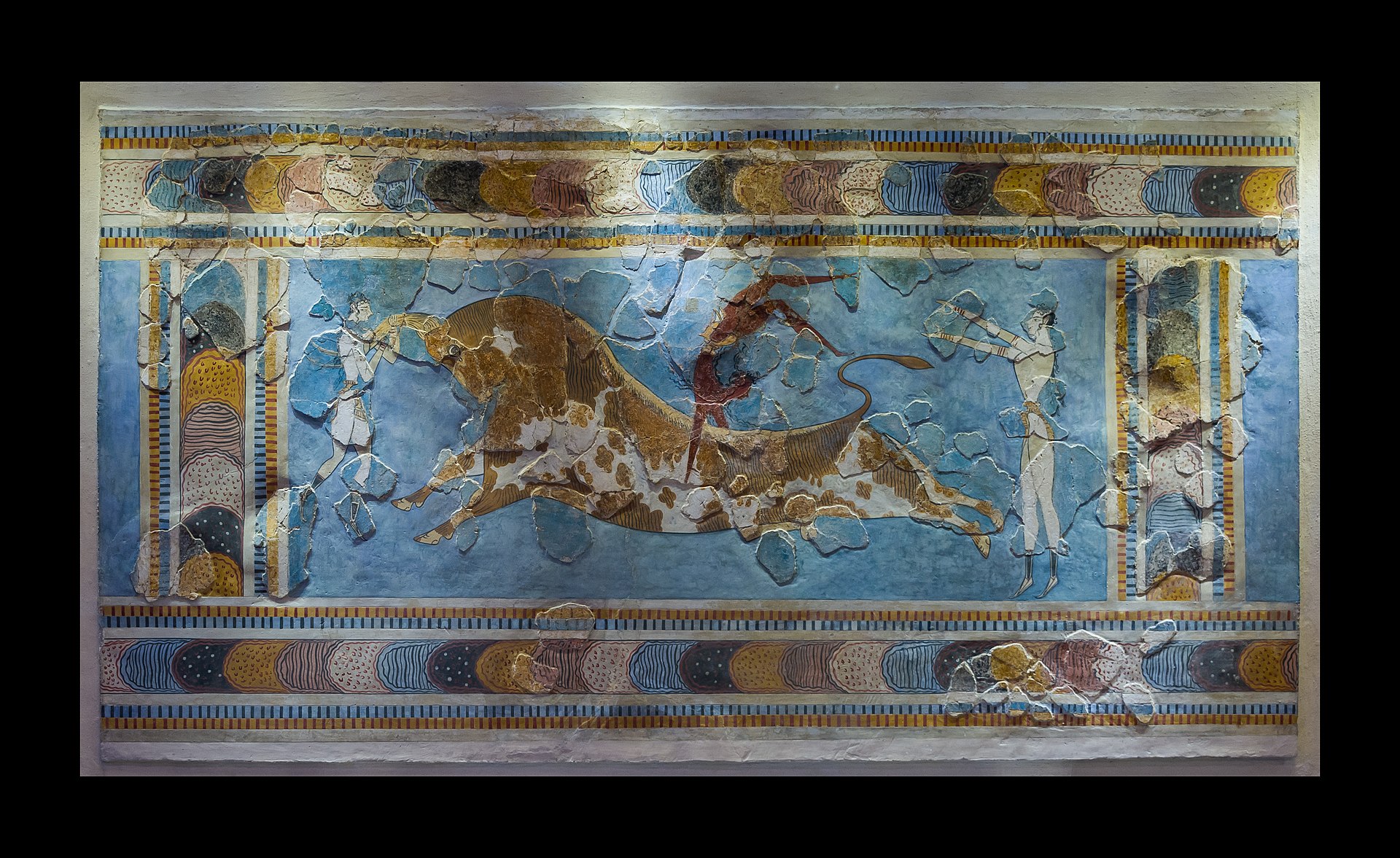































.jpg)

